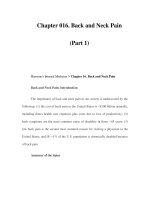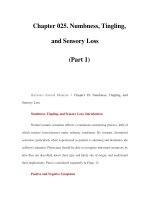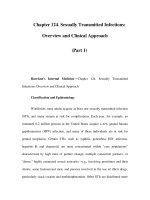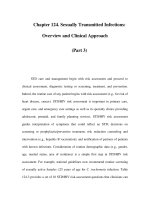Endocrinology Basic and Clinical Principles - part 1 ppsx
Bạn đang xem bản rút gọn của tài liệu. Xem và tải ngay bản đầy đủ của tài liệu tại đây (4.34 MB, 45 trang )
ndocrinology
Basic and Clinical
Principles
Shlomo Melmed
P. Michael Conn
e
ndocrinology
Basic and Clinical
Principles
SECOND EDITION
SECOND EDITION
Shlomo Melmed
P. Michael Conn
ENDOCRINOLOGY
E
NDOCRINOLOGY
Basic and Clinical Principles
S
ECOND
E
DITION
Edited by
SHLOMO MELMED, MD
Cedars Sinai Medical Center
and UCLA School of Medicine
P. M ICHAEL CONN, PhD
Oregon Health & Science University
Beaverton, OR
© 2005 Humana Press Inc.
999 Riverview Drive, Suite 208
Totowa, New Jersey 07512
For additional copies, pricing for bulk purchases, and/or information about other Humana titles,
contact Humana at the above address or at any of the following numbers: Tel.: 973-256-1699;
Fax: 973-256-8341, E-mail: ; or visit our Website:
All rights reserved.
No part of this book may be reproduced, stored in a retrieval system, or transmitted in any form or by any means, electronic, mechanical, photocopying,
microfilming, recording, or otherwise without written permission from the Publisher.
All articles, comments, opinions, conclusions, or recommendations are those of the author(s), and do not necessarily reflect the views of the publisher.
Due diligence has been taken by the publishers, editors, and authors of this book to assure the accuracy of the information published and to describe
generally accepted practices. The contributors herein have carefully checked to ensure that the drug selections and dosages set forth in this text are
accurate and in accord with the standards accepted at the time of publication. Notwithstanding, as new research, changes in government regulations, and
knowledge from clinical experience relating to drug therapy and drug reactions constantly occurs, the reader is advised to check the product information
provided by the manufacturer of each drug for any change in dosages or for additional warnings and contraindications. This is of utmost importance
when the recommended drug herein is a new or infrequently used drug. It is the responsibility of the treating physician to determine dosages and treatment
strategies for individual patients. Further it is the responsibility of the health care provider to ascertain the Food and Drug Administration status of each
drug or device used in their clinical practice. The publisher, editors, and authors are not responsible for errors or omissions or for any consequences
from the application of the information presented in this book and make no warranty, express or implied, with respect to the contents in this publication.
Cover design by Patricia F. Cleary.
This publication is printed on acid-free paper. ∞
ANSI Z39.48-1984 (American National Standards Institute) Permanence of Paper for Printed Library Materials.
Photocopy Authorization Policy:
Authorization to photocopy items for internal or personal use, or the internal or personal use of specific clients, is granted by Humana Press Inc.,
provided that the base fee of US $30 is paid directly to the Copyright Clearance Center at 222 Rosewood Drive, Danvers, MA 01923. For those
organizations that have been granted a photocopy license from the CCC, a separate system of payment has been arranged and is acceptable to Humana
Press Inc. The fee code for users of the Transactional Reporting Service is: [1-58829-427-7/05 $30].
Printed in the United States of America. 10 9 8 7 6 5 4 3 2 1
Library of Congress Cataloging-in-Publication Data
Endocrinology : basic and clinical principles / edited by Shlomo Melmed, P. Michael Conn.— 2nd ed.
p. cm.
Includes bibliographical references and index.
ISBN 1-58829-427-7 (alk. paper) eISBN 1-59259-829-3
1. Endocrinology. 2. Hormones. 3. Endocrine glands—Diseases. I. Melmed, Shlomo. II. Conn, P. Michael.
QP187.E555 2005
612.4—dc22 2004018638
v
Endocrinology: Basic and Clinical Principles, Sec-
ond Edition aims to provide a comprehensive knowl-
edge base for the applied and clinical science of
endocrinology. The challenge in its presentation was
to produce a volume that was timely, provided integra-
tion of basic science with physiologic and clinical prin-
ciples, and yet was limited to 500 pages. This length
makes the volume suitable as a text; and the timeliness
we have striven for allows the book to serve as an off-
the-shelf reference. Our goal was achieved largely
through the selection of authors who are both expert
writers and teachers. Tables and illustrative matter
were used optimally to present information in a con-
cise and comparative format.
Endocrinology: Basic and Clinical Principles, Sec-
ond Edition will be useful to physicians and scientists as
well as to students who wish to have a high-quality,
PREFACE
current reference to the general field of endocrinology.
The use of an outline system and a comprehensive index
will allow readers to locate promptly topics of particu-
lar interest. Key references are provided throughout for
individuals requiring more in-depth information. The
volume covers the comprehensive spectrum of current
knowledge of hormone production and action, even
including nonmammalian systems and plants, coverage
rarely included in similar volumes.
The editors wish to express appreciation to our dis-
tinguished chapter authors for their efforts, as well as
diligently meeting publication deadlines and to the staff
at Humana Press for their cooperation and useful sug-
gestions.
Shlomo Melmed
P. Michael Conn
Preface vii
Contributors ix
Value Added eBook xi
PART I. INTRODUCTION
1 Introduction to Endocrinology 3
P. Michael Conn
PART II. HORMONE SECRETION AND ACTION
2 Receptors: Molecular Mediators of Hormone Action 9
Kelly E. Mayo
3 Second-Messenger Systems
and Signal Transduction Mechanisms 35
Eliot R. Spindel
4 Steroid Hormones 49
Derek Henley, Jonathan Lindzey, and Kenneth S. Korach
5 Plasma Membrane Receptors for Steroid Hormones
in Cell Signaling and Nuclear Function 67
Richard J. Pietras and Clara M. Szego
6 Growth Factors 85
Derek LeRoith and William L. Lowe Jr.
7 Prostaglandins and Leukotrienes: Locally Acting Agents 93
John A. McCracken
8 The Neuroendocrine–Immune Interface 113
Michael S. Harbuz and Stafford L. Lightman
Part III. Insects/Plants/Comparative
9 Insect Hormones 127
Lawrence I. Gilbert
10 Phytohormones and Signal Transduction Pathways in Plants 137
William Teale, Ivan Paponov, Olaf Tietz, and Klaus Palme
11 Comparative Endocrinology 149
Fredrick Stormshak
vii
CONTENTS
Part IV. Hypothalamic–Pituitary
12 Hypothalamic Hormones:
GnRH, TRH, GHRH, SRIF, CRH, and Dopamine 173
Constantine A. Stratakis and George P. Chrousos
13 Anterior Pituitary Hormones 197
Ilan Shimon and Shlomo Melmed
14 Posterior Pituitary Hormones 211
Daniel G. Bichet
15 Endocrine Disease: Value for Understanding Hormonal Actions 233
Anthony P. Heaney and Glenn D. Braunstein
16 The Pineal Hormone (Melatonin) 255
Irina V. Zhdanova and Richard J. Wurtman
17 Thyroid Hormones (T
4
, T
3
) 267
Takahiko Kogai and Gregory A. Brent
18 Calcium-Regulating Hormones:
Vitamin D and Parathyroid Hormone 283
Geoffrey N. Hendy
19 Oncogenes and Tumor Suppressor Genes in Tumorigenesis
of the Endocrine System 301
Anthony P. Heaney and Shlomo Melmed
20 Insulin Secretion and Action 311
Run Yu, Hongxiang Hui, and Shlomo Melmed
21 Cardiovascular Hormones 321
Willis K. Samson and Meghan M. Taylor
22 Adrenal Medulla (Catecholamines and Peptides) 337
William J. Raum
23 Hormones of the Kidney 353
Masashi Mukoyama and Kazuwa Nakao
24 Reproduction and Fertility 367
Neena B. Schwartz
25 Endocrinology of Fat, Metabolism, and Appetite 375
Rachel L. Batterham and Michael A. Cowley
26 Endocrinology of the Ovary 391
Denis Magoffin, Ashim Kumar, Bulent Yildiz, and Ricardo Azziz
27 The Testis 405
Amiya Sinha Hikim, Ronald S. Swerdloff, and Christina Wang
28 Endocrinology of Aging 419
Steven W. J. Lamberts
Index 429
Contents viii
ix
RICARDO AZZIZ, MD, MPH, MBA • Department of
Obstetrics and Gynecology, Cedars-Sinai Medical
Center, UCLA School of Medicine, Los Angeles, CA
R
ACHEL L. BATTERHAM, MBBS, PhD • University College
London, London, UK
D
ANIEL G. BICHET, MD • Clinical Research Unit and
Nephrology Service, Hospital du Sacre-Coeur de
Montreal, Montreal, Canada
G
LENN D. BRAUNSTEIN, MD • Department of Medicine,
Cedars-Sinai Medical Center, UCLA School
of Medicine, Los Angeles, CA
G
REGORY A. BRENT, MD • Departments of Medicine
and Physiology, UCLA School of Medicine,
Los Angeles, CA
G
EORGE P. CHROUSOS, PhD • National Institute of Child
Health & Human Development, National Institutes
of Health, Bethesda, MD
P. M
ICHAEL CONN, PhD • Oregon National Primate
Research Center, Oregon Health and Science
University, Beaverton, OR
M
ICHAEL A. COWLEY, PhD • Oregon National Primate
Research Center, Oregon Health and Science
University, Beaverton, OR
L
AWRENCE I. GILBERT, PhD • Department of Biology,
University of North Carolina, Chapel Hill, NC
MICHAEL S. HARBUZ, PhD • Department of Medicine,
Henry Wellcome Laboratories for Integrated
Neuroscience and Endocrinology, University
of Bristol, Bristol, UK
A
NTHONY P. HEANEY, MD, PhD • Division of
Endocrinology and Metabolism, Cedars-Sinai
Medical Center, UCLA School of Medicine, Los
Angeles, CA
GEOFFREY N. HENDY, PhD • Department of Medicine,
Royal Victoria Hospital, McGill University,
Montreal, Canada
D
EREK V. HENLEY, PhD • Laboratory of Reproductive
and Developmental Toxicology, National Institute
of Environmental Health Sciences, National
Institutes of Health, Research Triangle Park, NC
A
MIYA SINHA HIKIM, PhD • Division of Endocrinology,
Department of Medicine, Harbor-UCLA Medical
Center and Education and Research Institute,
UCLA School of Medicine, Torrance, CA
CONTRIBUTORS
HONGXIANG HUI, MD, PhD • Division of Endocrinology,
Cedars-Sinai Medical Center, UCLA School
of Medicine, Los Angeles, CA
T
AKAHIKO KOGAI, MD, PhD • Division of Endocrinology
and Diabetes, VA Greater Los Angeles Healthcare
System, UCLA School of Medicine,
Los Angeles, CA
K
ENNETH S. KORACH, PhD • Laboratory of Reproductive
and Developmental Toxicology, National Institute
of Environmental Health Sciences, National
Institutes of Health, Research Triangle Park, NC
A
SHIM KUMAR, MD • Department of Obstetrics and
Gynecology, Cedars-Sinai Medical Center, UCLA
School of Medicine, Los Angeles, CA
S
TEVEN W. J. LAMBERTS, MD, PhD • Department
of Medicine, Erasmus Medical Center, Rotterdam,
The Netherlands
D
EREK LEROITH, MD, PhD • Diabetes Branch, National
Institutes of Health, Bethesda, MA
STAFFORD L. LIGHTMAN, PhD • Department of Medicine,
Henry Wellcome Laboratories for Integrated
Neuroscience and Endocrinology, University
of Bristol, Bristol, UK
J
ONATHAN LINDZEY, PhD • Department of Natural
Sciences, Clayton College and State University,
Morrow, GA
W
ILLIAM L. LOWE JR., MD • Department of Medicine,
Northwestern University Medical School,
Chicago, IL
D
ENIS MAGOFFIN, PhD • Department of Obstetrics and
Gynecology, Cedars-Sinai Medical Center, UCLA
School of Medicine, Los Angeles, CA
K
ELLY E. MAYO, PhD • Department of Biochemistry,
Molecular Biology, and Cell Biology, Center
for Reproductive Science, Northwestern University,
Evanston, IL
JOHN A. MCCRACKEN, PhD • University of Connecticut,
Storrs, CT
S
HLOMO MELMED, MD • Division of Endocrinology and
Metabolism, Cedars-Sinai Medical Center, UCLA
School of Medicine, Los Angeles, CA
M
ASASHI MUKOYAMA, MD, PhD • Department of Medicine
and Clinical Science, Kyoto University Graduate
School of Medicine, Kyoto, Japan
KAZUWA NAKAO, MD, PhD • Department of Medicine
and Clinical Science, Kyoto University Graduate School
of Medicine, Kyoto, Japan
K
LAUS PALME, PhD • Institute for Biology,
Albert-Ludwigs-Universität Freiburg, Freiburg,
Germany
I
VAN PAPONOV, PhD • Institute for Biology,
Albert-Ludwigs-Universität Freiburg, Freiburg,
Germany
R
ICHARD J. PIETRAS, MD, PhD • Department
of Medicine, Division of Hematology-Oncology,
Jonsson Comprehensive Cancer Center, UCLA
School of Medicine, Los Angeles, CA
W
ILLIAM J. RAUM, MD, PhD • Departments of Medicine
and Surgery, Louisiana State University Medical
Center, New Orleans, LA
W
ILLIS K. SAMSON, PhD • Department of
Pharmacologic and Physiologic Science, St.
Louis University School of Medicine, St. Louis,
MO
N
EENA B. SCHWARTZ, PhD • Department of Neuro-
biology and Physiology, Northwestern University,
Evanston, IL
I
LAN SHIMON, MD • Institute of Endocrinology, Sheba
Medical Center, Tel-Hashomer, Israel
ELIOT R. SPINDEL, MD, PhD • Oregon National Primate
Research Center, Oregon Health and Science
University, Beaverton, OR
F
REDRICK STORMSHAK, PhD • Departments of
Biochemistry/Biophysics and Animal Sciences,
Oregon State University, Corvalis, OR
C
ONSTANTINE A. STRATAKIS, PhD, DSc • National
Institutes of Health, Bethesda, MD
R
ONALD S. SWERDLOFF, MD • Division of Endocrinology,
Department of Medicine, Harbor-UCLA Medical
Center and Education and Research Institute,
UCLA School of Medicine, Torrance, CA
C
LARA M. SZEGO, PhD • Department of Molecular,
Cellular,
and Developmental Biology, Molecular
Biology Institute, University of California, Los
Angeles, CA
MEGHAN M. TAYLOR, PhD • Department of Pharma-
cologic and Physiologic Science, St. Louis
University School of Medicine, St. Louis, MO
W
ILLIAM TEALE, PhD • Institute for Biology, Albert-
Ludwigs-Universität Freiburg, Freiburg, Germany
OLAF TIETZ, PhD • Institute for Biology, Albert-Ludwigs-
Universität Freiburg, Freiburg, Germany
CHRISTINA WANG, MD • Division of Endocrinology,
Department of Medicine, General Clinical
Research Center, Harbor-UCLA Medical Center
and Education and Research Institute, UCLA
School of Medicine, Torrance, CA
R
ICHARD
J. W
URTMAN
,
MD
• Department of Brain
and Cognitive Sciences, Clinical Research Center,
Massachusetts Institute of Technology,
Cambridge, MA
BULENT YILDIZ, MD • Interdepartmental Clinical
Pharma-cology Center, UCLA School of Medicine,
Los Angeles, CA
R
UN YU, MD, PhD • Division of Endocrinology, Cedars-
Sinai Medical Center, UCLA School of Medicine, Los
Angeles, CA
I
RINA V. ZHDANOVA, MD, PhD • Department of Anatomy
and Neurobiology, Boston University School
of Medicine, Boston, MA
x Contributors
Value-Added eBook/PDA on CD-ROM
This book is accompanied by a value-added CD-ROM that contains an eBook version of the volume you have
just purchased. This eBook can be viewed on your computer, and you can synchronize it to your PDA for
viewing on your handheld device. The eBook enables you to view this volume on only one computer and PDA.
Once the eBook is installed on your computer, you cannot download, install, or e-mail it to another computer;
it resides solely with the computer to which it is installed. The license provided is for only one computer. The
eBook can only be read using Adobe
®
Reader
®
6.0 software, which is available free from Adobe Systems
Incorporated at www.Adobe.com. You may also view the eBook on your PDA using the Adobe
®
PDA Reader
®
software that is also available free from Adobe.com.
You must follow a simple procedure when you install the eBook/PDA that will require you to connect to the
Humana Press website in order to receive your license. Please read and follow the instructions below:
1. Download and install Adobe
®
Reader
®
6.0 software.
You can obtain a free copy of the Adobe
®
Reader
®
6.0 software at www.adobe.com
*Note: If you already have the Adobe
®
Reader
®
6.0 software installed, you do not need to reinstall it.
2. Launch Adobe
®
Reader
®
6.0 software
3. Install eBook: Insert your eBook CD into your CD-ROM drive
PC: Click on the “Start” button, then click on “Run”
At the prompt, type “d:\ebookinstall.pdf” and click “OK”
*Note: If your CD-ROM drive letter is something other than d: change the above command
accordingly.
MAC: Double click on the “eBook CD” that you will see mounted on your desktop.
Double click “ebookinstall.pdf”
4. Adobe
®
Reader
®
6.0 software will open and you will receive the message
“This document is protected by Adobe DRM” Click “OK”
*Note: If you have not already activated the Adobe
®
Reader
®
6.0 software, you will be prompted
to do so. Simply follow the directions to activate and continue installation.
Your web browser will open and you will be taken to the Humana Press eBook registration page. Follow
the instructions on that page to complete installation. You will need the serial number located on the sticker
sealing the envelope containing the CD-ROM.
If you require assistance during the installation, or you would like more information regarding your eBook
and PDA installation, please refer to the eBookManual.pdf located on your cd. If you need further assistance,
contact Humana Press eBook Support by e-mail at
or by phone at 973-256-
1699.
*Adobe and Reader are either registered trademarks or trademarks of Adobe Systems Incorporated in the
United States and/or other countries.
xi
Chapter 1 / Short Chapter Title 1
INTRODUCTION
PART
I
2 Part I / Introduction
Chapter 1 / Short Chapter Title 3
3
From: Endocrinology: Basic and Clinical Principles, Second Edition
(S. Melmed and P. M. Conn, eds.) © Humana Press Inc., Totowa, NJ
1
Introduction to Endocrinology
P. Michael Conn, PhD
CONTENTS
INTRODUCTION
DEFINITIONS
HORMONES CONVEY INFORMATION THAT REGULATES CELL PROCESSES
IDENTIFYING HORMONES
HORMONE-DERIVED DRUGS
ENDOCRINOLOGY AS A LEAD SCIENCE
responses in another animal are referred to as phero-
mones.
Sometimes the word hormone is used as a reference
to substances in plants (phytohormones) or in inverte-
brates that have open “circulatory” systems very dif-
ferent from those found in vertebrates. On other
occasions, growth factors are (appropriately) called
hormones, because they mediate signaling between
cells. In recent years, the word has become a catchall to
describe substances released by one cell that provoke a
response in another cell even when the messenger sub-
stance does not enter the general circulation. The sci-
ence of endocrinology has broad coverage indeed.
3. HORMONES CONVEY INFORMATION
THAT REGULATES CELL PROCESSES
Characteristically, hormones transmit information
about the status of one organ to another, regulating cor-
rective actions to maintain homeostasis. For example,
elevated glucose in the blood signals the pancreas to
release insulin. Insulin travels through the circulation,
signaling target cells in liver and fat cells to increase
their permeability to glucose; conversely, processed
sugar is stored in cells as blood levels drop.
1. INTRODUCTION
The earliest bacterial fossils date back about 3 bil-
lion years. That was a simpler time! Communications
between cells were more modest than those required to
maintain a multicellular organism and were probably
focused on the ability to signal the presence of benefi-
cial substances (food) or deleterious substances (tox-
ins) in the local environment.
2. DEFINITIONS
Substances that provide the chemical basis for com-
munication between cells are called hormones. This
word, coined by Bayliss and Starling, was originally
used to describe the products of ductless glands
released into the general circulation in order to respond
to changes in homeostasis. Hormone has taken on a
broader usage in recent years. Sometimes hormones
are released into portal (closed) circulatory systems
and have local actions. The word paracrine is used to
describe the release of locally acting substances. This
word also describes local hormone action as the diffu-
sion of gastric juice acts on neighboring cells. Hor-
monal substances released by an animal that influence
4 Part I / Introduction
To be effective, hormones should not be degraded
too quickly (i.e., before arrival at the target site). If
degradation is too slow, on the other hand, the infor-
mation conveyed will be obsolete and may evoke an
inappropriate response. Accordingly, it is not surpris-
ing that different hormones have varying half-lives in
the circulation, depending, in part, on the distance that
the signal must travel and the nature of the information
to be conveyed.
Concentrations of hormones are sensed by recep-
tors, usually proteins, located on the surface (i.e.,
plasma membrane) or inside target cells. Receptors
bind their respective hormone ligands with high affin-
ity and specificity. For example, although estrogen and
testosterone are chemically similar, receptors must dis-
tinguish between them because they mediate very dif-
ferent cellular responses indeed. When hormone
receptors are situated on the surface of target cells and
the response involves intracellular changes (e.g., evok-
ing secretione), transduction of the hormonal message
must occur. Such transduction molecules are termed
second messengers of hormone action.
It is a general truth that the chemical structures of
hormones do not change markedly during evolution;
instead, nature identifies and conserves molecules that
already have information value and develops systems
that preserve and utilize that information. Steroids, thy-
roid hormones, and peptides are present in some species
that do not utilize them for the same endocrine purpose
as do mammals.
4. IDENTIFYING HORMONES
The effects of ablation of endocrine organs have
been documented back to the time of Aristotle (384–
322
BC), who described changes in secondary sex char-
acteristics and loss of reproductive capacity associated
with castration in men. Much insight into the role of
endocrine substances has come from disease states,
surgical errors, and animal experimentation in which
damage to endocrine organs is correlated with particu-
lar phenotypic changes in the organism.
Ancient medical procedures prevalent in many cul-
tures were based on the premise that administration of
extracts from healthy organs aids in the recovery of dis-
eased organs. This practice may be viewed as a prede-
cessor to hormone replacement therapy. Restoration of
function by supplements derived from healthy endo-
crine organs administered to animals with endocrine
ablations has formed the basis of discovering active
principles of the endocrine system.
In the mid-1800s, Berthold showed that the effects of
castration in avians could be reversed by placing a testis
in the body cavity. Since the transplant was ectopic and
not innervated, he concluded that the testes released a
substance that controlled secondary sex characteristics.
A few years later, Claude Bernard, providing evi-
dence to support a model of homeostasis, showed that
the liver could release sugar to the blood. From the mid-
1850s to the twentieth century, endocrinology grew at a
dramatic pace. Assays became more sensitive and spe-
cific; biosynthetic and genetic engineering techniques
now allow synthesis of biologically active and highly
purified hormones.
5. HORMONE-DERIVED DRUGS
The identification of new hormonal activities often
follows a similar pattern. The observation is made that
damage to a particular gland is associated with loss of a
certain function. Efforts are then focused on isolating
the active principle from the gland. The active principle
is then administered to restore the function to the animal
patient who has ablated glandular function. The devel-
opment of drugs is usually directed toward preparing
purified fractions that can be used in replacement
therapy. The hormone itself and, ultimately, chemical
analogs can now readily be synthesized. Analogs can be
designed to possess desirable properties, such as pro-
longed circulation half-lives, chemical stability, or spe-
cific receptor or tissue targeting. The availability of
purified fractions or synthetic hormone preparations
often spawns studies designed to understand the cellular
and molecular basis of hormone action. This informa-
tion is then used to design even more useful drugs that
recognize the target cell receptor with higher specificity
and affinity; antagonists can also be prepared that block
the receptor or its signaling. The science of endocrinol-
ogy is poised to take advantage of our understanding of
intricate second-messenger systems, sensitive and pre-
cise assay systems (radioimmunoassays, bioassays,
radioligand assays), and advances in structural and func-
tional molecular biology. As the tools of endocrinology
have become more precise, we have discovered that even
the brain, heart, and lung possess substantial endocrine
functions.
6. ENDOCRINOLOGY
AS A LEAD SCIENCE
Endocrinology continues to be a lead science. Many
Nobel Prizes have recognized the contributions of endo-
crinologists. The first cloned gene products to reach the
clinical pharmaceutical market were endocrine sub-
stances. Many advances in our understanding of cellular
transduction systems, receptor binding, and physiologic
regulation are derivatives of the studies conducted in
endocrine laboratories. Why is this so? A likely answer
Chapter 1 / Short Chapter Title 5
is found by understanding that endocrinologists study
the actions of specific chemicals that cause cells to
undergo specific and (usually) easily quantifiable and
regulated responses. These are very simple, basic, and
well-defined processes. Accordingly, clear and inter-
pretable experiments can be designed at a complexity
ranging from molecular to physiologic. This is part of
the general appeal and high level of achievement of this
science—and much of the reason that those who call
themselves endocrinologists have made a major contri-
bution to our understanding of regulatory biologic pro-
cesses.
Chapter 2 / Receptors 7
HORMONE SECRETION AND ACTION
PART
II
8 Part II / Hormone Secretion and Action
Chapter 2 / Receptors 9
9
From: Endocrinology: Basic and Clinical Principles, Second Edition
(S. Melmed and P. M. Conn, eds.) © Humana Press Inc., Totowa, NJ
2
Receptors
Molecular Mediators of Hormone Action
Kelly E. Mayo, PhD
CONTENTS
INTRODUCTION
GENERAL ASPECTS OF RECEPTOR ACTION
CELL-SURFACE RECEPTORS
INTRACELLULAR RECEPTORS
RECEPTORS, HEALTH, AND DISEASE
CONCLUSION
1. INTRODUCTION
The appropriate proliferation and differentiation of
cells during development and the maintenance of cellu-
lar homeostasis in the adult require a continuous flow of
information to the cell. This is provided either by diffus-
ible signaling molecules or by direct cell–cell and cell–
matrix interactions. All cells utilize a wide variety of
signaling molecules and signal transduction systems to
communicate with one another, but within the verte-
brate endocrine system, it is the secreted hormones that
are classically associated with cellular signaling. Hor-
mones are chemical messengers produced from the en-
docrine glands that act either locally or at a distance to
regulate the activity of a target cell. As discussed in
detail elsewhere within this volume, prominent groups
of hormonal agents include peptide hormones; steroid,
retinoid, and thyroid hormones; growth factors; cyto-
kines; pheromones; and neurotransmitters or neuro-
modulators.
Endocrine signaling molecules exert their effects by
interacting with specific receptor proteins that are gen-
erally coupled to one or more intracellular effector sys-
tems. The presence of an appropriate receptor therefore
defines the population of target cells for a given hor-
mone and provides a molecular mechanism by which
the hormone elicits its biologic actions. These hormone
receptor proteins are the focus of this chapter. Section 2
considers general concepts of receptor action, including
receptor structure, interaction with the hormone ligand,
activation of cellular effector systems, and receptor
regulation. Sections 3 and 4 then examine the major
families of hormone receptors, grouped with respect
to their structures and signaling properties, in greater
detail, using specific examples that illustrate the general
features of each family. Finally, Section 5 discusses
some of the endocrinopathies that result from known
alterations in hormone receptor structure or function.
2. GENERAL ASPECTS
OF RECEPTOR ACTION
2.1. Receptors as Mediators
of Endocrine Signals
The concept that hormone action is mediated by
receptors is most often attributed to the work of Langley
on the actions of nicotine and curare on the neuromus-
10 Part II / Hormone Secretion and Action
cular junction (Langley, 1906). Langley referred to the
target for these compounds as the “receptive substance,”
and postulated that “it receives the stimulus, and by
transmitting it, causes contraction,” a clear description
of the role of receptors in mediating the actions of sig-
naling molecules. Of course, Langley could not know
the nature of these receptive substances, suggesting only
that they were “radicals of the protoplasmic molecule.”
Indeed, despite a wealth of physiologic evidence in
support of the receptor concept, firm biochemical evi-
dence for the existence of specific receptors was not
forthcoming until radiolabeled hormones became avail-
able. For hormones unable to traverse the cellular mem-
brane, such as the polypeptide hormones, specific
binding sites could be demonstrated, but their mem-
brane association and low abundance precluded their
characterization for many years. Only with the advent
of molecular cloning techniques was it possible to
establish firmly the structures of the hormone receptors,
and to show that these proteins could, in effect, convert
a nontarget cell into a target cell by conferring to the cell
the ability to bind and, in some cases, appropriately
respond to the corresponding hormone.
A second key event in the development of the recep-
tor concept was the demonstration by Sutherland (1972)
that cyclic adenosine monophosphate (cAMP) could
mediate the intracellular effects of many different hor-
mones, establishing the notion of “second messengers”
and providing a cogent molecular explanation of how
hormones and hormone receptors might elicit their
widespread effects on cellular activity. The notion that
many different signaling molecules, working through
distinct receptors, could stimulate a common intracellu-
lar signaling pathway, together with the subsequent dis-
covery of additional effector enzymes and intracellular
second messengers, provided a rational explanation for
the tremendous diversity in cellular responses to hor-
mones.
At about the time that second-messenger systems
were being discovered, different concepts were evolv-
ing on the mechanism of action of the small lipophilic
steroid hormones. Radiolabeled steroids, such as estro-
gen, were synthesized by Jensen and others and were
found to accumulate preferentially in known target
organs for the hormone (Jensen and Jacobson, 1962).
Specific steroid-binding proteins were subsequently
identified, and the important finding that binding of
agonists and antagonists to these receptors correlated
with their biologic activity provided evidence that they
were direct mediators of steroid action. These steroid
receptors were shown to be soluble intracellular pro-
teins, differentiating them from the membrane-associ-
ated receptors for the polypeptide hormones, and
facilitating their early purification, beginning with the
identification of the estrogen receptor by Toft and
Gorski (1966). The findings that the steroid receptors
associated with chromatin in the cell nucleus and that
steroid hormones affected RNA and protein synthesis
provided the basis for models of direct genomic actions
of the hormone-receptor complex that we now know to
be correct.
2.2. Membrane-Associated
vs Intracellular Receptors
Substances that act as signaling molecules have
extremely diverse structures and chemical properties.
They include complex multisubunit proteins such as
follicle-stimulating hormone (FSH), small peptides
such as somatostatin, steroids such as estrogen, amino
acid derivatives such as thyroid hormone or the cat-
echolamines, vitamin derivatives such as the retinoids
or calcitrol, fatty acid derivatives such as prostaglan-
dins, and simple compounds such as nitric oxide (NO),
to provide but a few examples. Despite this structural
complexity, most hormones act on target cells through
one of two basic mechanisms. Small lipophilic mol-
ecules such as the steroids, retinoids, calcitrol, and thy-
roid hormone are able to enter cells directly by
diffusion across the lipid bilayer, where they bind to
intracellular receptors that mediate their subsequent
action by directly regulating gene expression. By con-
trast, hydrophilic molecules such as the protein and
peptide hormones must bind to their receptor at the cell
surface, and the receptors are therefore typically inte-
gral membrane proteins that activate intracellular sig-
nal transduction cascades. Thus, it is common to
differentiate between membrane-bound and intracel-
lular receptors when considering mechanisms of hor-
mone action.
The consequence of hormone-receptor interaction
is the activation of pathways that lead to an appropriate
biologic response in the target cell, an area referred to
as a signal transduction, which is discussed in depth in
Chapter 3. Briefly, most intracellular receptors, such
as the steroid hormone receptors, are ligand-activated
transcription factors that directly regulate the tran-
scriptional activity of target genes. By contrast, cell-
surface receptors transduce a signal to the cell interior,
directly or indirectly altering the activity of proteins
within the cell. This action often involves the enzy-
matic generation of a second messenger, and the
activation of protein phosphorylation or dephosphory-
lation cascades. More important, the eventual conse-
quence of the activation of enzymatic signaling
pathways by cell-surface receptors is often a change in
gene transcription; conversely, changes in enzymatic
Chapter 2 / Receptors 11
activities often follow as a consequence of altered gene
activity when intracellular receptors are activated. Fur-
thermore, there are many emerging examples of “cross
talk” between cell-signaling pathways (Dumont et al.,
2001). Finally, as our understanding of the complexity
of receptor signaling increases, exceptions to these
general modes of action of membrane-bound vs intra-
cellular receptors are being identified. Thus, many of
the historical mechanistic boundaries between cell-
surface and intracellular receptors are breaking down.
Nonetheless, these categories provide a useful way of
organizing thinking about receptor action and are
therefore used to classify the receptors in this chapter.
Figure 1 illustrates some of the similarities and differ-
ences in hormone signaling through intracellular vs
cell-surface receptors.
The membrane-associated receptors are an extremely
diverse group of signaling molecules. Their common
feature is the presence of one or more hydrophobic
domains that span the cell membrane and anchor the
receptor at the cell surface. Extracellular regions of the
protein often participate in hormone binding, and intra-
cellular sequences generally either have direct enzy-
matic function or associate with intermediary proteins
or effector enzymes. The functional cell-surface hor-
mone receptor is often composed of multiple protein
subunits that may play a role in hormone binding, sig-
naling, or both activities. It is clear that the receptors for
structurally and functionally diverse hormones can be
closely related to one another, most commonly within
their intracellular domains. Thus, a limited number of
basic signaling strategies are used repetitively by a
very large number of receptor proteins, defining distinct
receptor families, which are considered in Section 3.
The intracellular receptors for the steroid hormones
were the first to be biochemically purified. Following
the molecular cloning of the receptors for all of the clas-
sic steroid hormones (Evans, 1988) it became clear that
Fig 1. Hormonal signaling by cell-surface and intracellular receptors. Protein hormones (P) bind to cell-surface receptors that activate
intracellular effector enzymes, often leading to the production of second messengers or the initiation of protein phosphorylation
cascades. A longer-term effect is gene transcription and new protein synthesis. By contrast, steroid hormones (S), or other lipophilic
ligands, bind to intracellular receptors that are ligand-activated transcription factors (TF) that directly mediate gene transcription,
leading to new protein synthesis.
12 Part II / Hormone Secretion and Action
these receptors comprise a family of highly related pro-
teins consisting of distinct structural domains. The
highly conserved central DNA-binding domain (DBD)
is generally flanked by a carboxyl-terminal region that
is necessary for hormone binding by one or more addi-
tional domains that are important for activation of target
gene transcription. The subsequent identification of the
thyroid hormone, retinoic acid, and vitamin D receptors
placed them in this nuclear receptor superfamily, along
with an expanding number of “orphan receptors” that
act in a ligand-independent fashion or for which appro-
priate ligands have not yet been identified (Willson and
Moore, 2002). Not all intracellular receptors are struc-
turally related to the steroid hormone receptors, some
examples being the NO and arylhydrocarbon receptors.
2.3. Measurement
of Receptor-Ligand Interaction
Hormone receptors are most commonly detected and
measured using direct binding assays. This requires a
labeled ligand, usually a radiolabeled hormone such as
a tritiated steroid or an iodinated peptide; a source of the
receptor being analyzed, typically tissue extracts, cells,
or cell membranes; and a physical means of separating
the bound hormone from that which is unbound, com-
monly centrifugation or filtration techniques. As shown
in Fig. 2A, when increasing amounts of a labeled
polypeptide hormone are added to a constant amount of
a cell preparation, the fraction of hormone bound to the
cell surface increases and eventually approaches a maxi-
mum. In addition to specific binding to its cell surface
receptor, the hormone can bind nonspecifically to other
cellular constituents or to the reaction vessel, and this
component is commonly measured by performing the
binding reaction in the presence of a large excess of
unlabeled hormone, to ensure complete displacement of
the labeled hormone from specific sites. Specific bind-
ing is then established by subtracting the nonspecific
binding from the total binding.
In a useful variation of this assay, a competition bind-
ing experiment, a constant, small amount of the labeled
hormone is mixed with cells or cell membranes in the
presence of increasing concentrations of unlabeled hor-
mone. A typical competition or displacement curve re-
Fig. 2. Measurement of hormone-receptor interactions by binding analysis: (A) saturable binding to a target cell preparation as
concentration of radiolabeled hormone is increased; (B) competition or displacement experiment in which binding of a radiolabeled
tracer to the receptor is competed as excess unlabeled hormone is added; (C) Scatchard linear transformation of binding data, from
which receptor number and affinity for hormone can be determined; (D) consequence of spare receptors. The biologic response is
fully activated when only a fraction of the receptors is occupied by hormone. See text for details.









